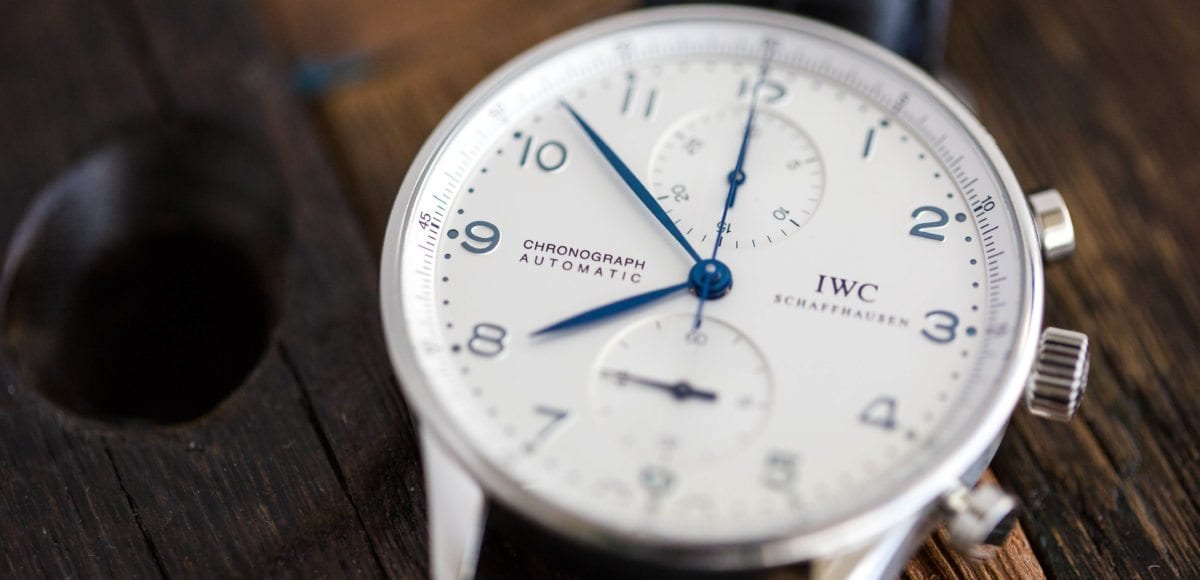The History of the Chronograph
Ask three different watch collectors who produced the world’s first automatic chronograph, and you’ll receive three different answers. Some will insist it was Zenith, who announced their El Primero movement in January of 1969. This marked the first automatic chronograph announced to the public. Others will claim it was Seiko, who released the 6139 automatic chronograph in May 1969 exclusively in the Japanese market. Most, however, will point to Heuer’s famous Caliber 11 movement. This was a product of years of work by Heuer, Breitling, Buren, and Dubois-Depraz. They released the Caliber 11 in August of 1969 inside the new Carrera, Monaco, and Autavia. Who produced the world’s first automatic chronograph is debatable, but the history of the chronograph isn’t. Learn more about the history & popular chronographs.
Watchmaking History Rewritten
Until recently, the history of the chronograph was well established. French watchmaker Nicolas Mathieu Rieussec invented and named the chronograph in 1821. The design spurred from the need to accurately time horses racing on the Champ de Mars. The next year, he filed for a patent on the device, calling it the “seconds chronograph.” It boasted incredible accuracy for the time, with the ability to time events to a tenth of a second.
Nicolas Mathieu Rieussec’s achievement was regarded as the world’s first chronograph watch until the beginning of 2013. Early that year, the world recognized another chronograph five years older and built for a different purpose, and a French watchmaker named Louis Moinet altered watchmaking history. In 1815, Moinet designed a pocket stopwatch for astronomers. The device could measure recorded time to 1/60th of a second. This was an incredible degree of precision for such an early timepiece. He achieved this precision through a running speed of 216,000 vibrations per hour, or 30 Hz. When Christie’s auctioned the watch in 2012, it sold for just 62,500 CHF ($67,443) and went largely unnoticed by many bidders.
The World’s First Chronograph Wristwatch
Just a decade after the turn of the century, companies began to experiment with turning pocket watches into wrist chronographs. Soon, they were in high demand for military forces, aviators, and automobile racers. In 1913, Longines built a monopusher chronograph using the company’s 13.33Z caliber movement. Accurate to a fifth of a second, it spawned numerous chronographs from competitors over the next decade. Two years later in 1915, Breitling released the first chronograph wristwatch with an independent push piece. Universal Genève followed with its own wristwatch chronograph in 1917. Then, other brands followed with their own chronograph wristwatches over the next decade.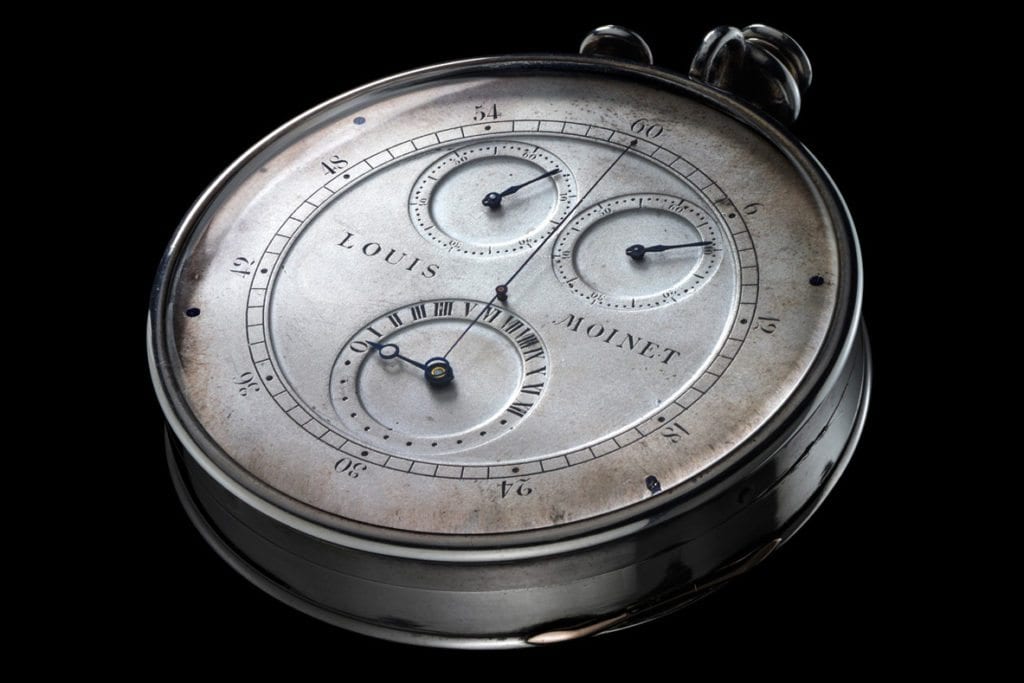
Heuer’s Innovative Rotating Tachymeter
Throughout the early twentieth century, chronograph wristwatches grew in popularity and developed new features. Tachymeter scales appeared on the bezels of some chronograph watches for the use of aviators and racers. In 1958, Heuer started incorporating a rotating bezel in
to some of its dashboard timepieces. This helped with the measurement of time and distance during races. Over the following years, that bezel developed into a version with a rotating tachymeter. In 1967, the rotating tachymeter bezel made its way into the new version of the Heuer Autavia. Then, it became the first chronograph watch to feature it. The Autavia went on to become one of the most popular wristwatches for racers and racing enthusiasts.
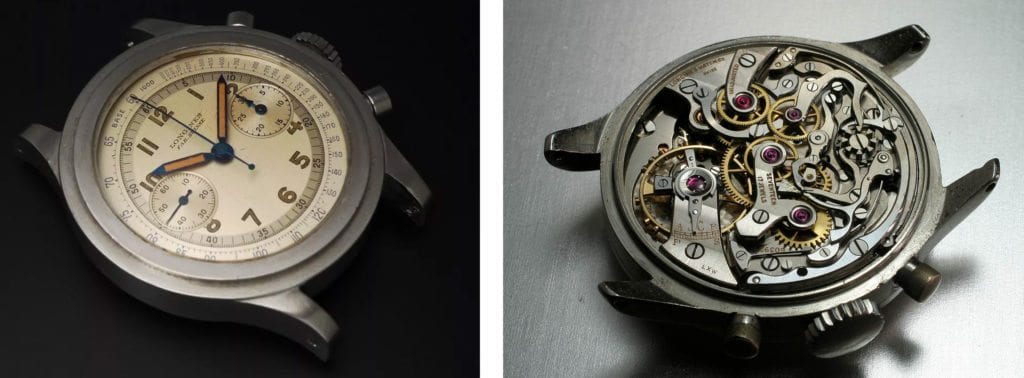
1969: The First Automatic Chronographs
In 1969, the first automatic chronograph launched. Working in a secret joint venture called Project 99, Heuer, Breitling, Buren, and Dubois-Depraz created the Caliber 11 also known as the “Chronomatic.” They debuted it to the media in simultaneous press conferences held in New York, Geneva, Hong Kong and Beirut. Heuer went on to release the Caliber 11 and later 12 in three watches: the Carrera, Autavia, and Monaco. Breitling released the Chrono-Matic, Automatic Navitimer, Co-Pilot, and Chronomat. These first Chrono-Matic watches remain valuable collector pieces today. Later in 1969 at the annual Basel Fair, other brands followed suit. Zenith released the iconic El Primero, the world’s fastest oscillating chronograph at 36,000 beats per hour. In addition, Seiko introduced its Caliber 6139, the first full rotor, vertical clutch, column wheel, self-winding chronograph.
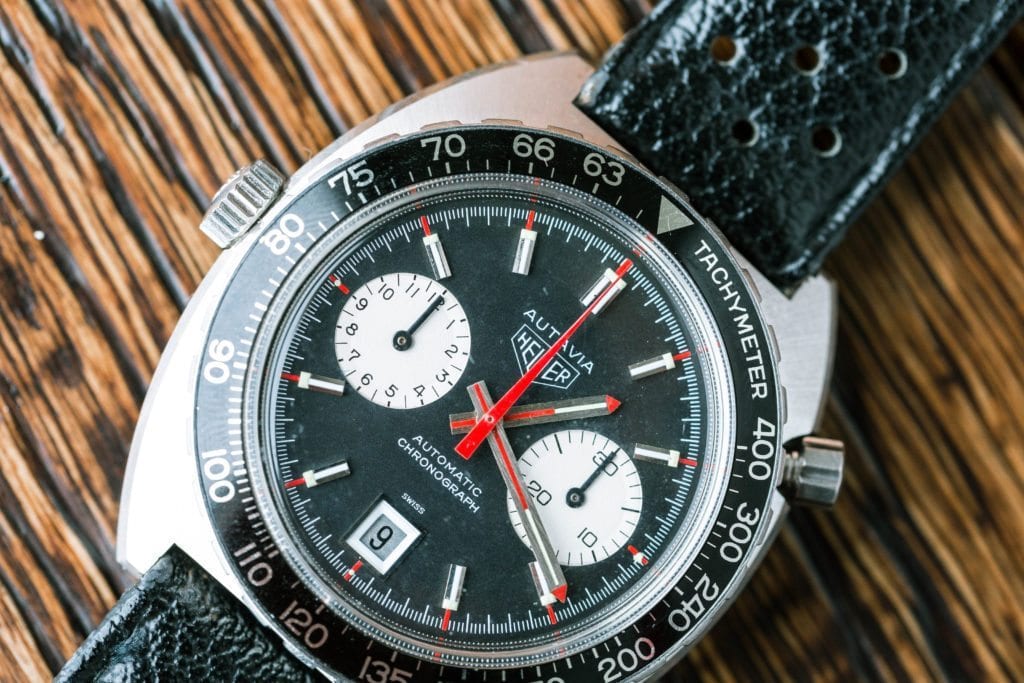
Evolution of the Chronograph Today
In more recent years, watchmakers have worked to further perfect the chronograph mechanism. Their focus has been in two key areas: size and precision. In 1987, Frederic Piguet produced the smallest and slimmest automatic chronograph movement for the time. Its height measured just 5.5mm. Blancpain used this caliber in its ultra-slim chronograph models. In 2019, Bulgari set a new world record with the Octo Finissimo Chronograph, measuring only 3.3mm.
Today, chronographs are able to record time to fractions of a second. TAG Heuer has continued to be a leader in this area of precision. For instance, their Mikrotimer Flying 1000 divides time to 1/1000th of a second. In addition, their Mikrogirder replaces the traditional escapement with a vibrating blade. This allows the movement to reach an astonishing 7,200,000 vph with a reading of 1/2,000th of a second.
Popular Chronographs across Brands
Since its inception, the chronograph has become one of the most accessible and popular complications in the industry. Whether you have a modest budget or whether the sky’s the limit, there’s a chronograph for you. Here, we’ve complied a few of our favorites.
Bell & Ross Heritage Chronograph
As the name suggests, the Bell & Ross Heritage Chronograph draws from the brand’s early designs. This two-register chronograph features an aged dial with artificial patina effects and a domed crystal. These vintage elements are contrasted by modern ones, like an oversized 43mm construction and sporty rubber strap. Under the hood, of course, is an automatic chronograph movement: the ETA 2824. It comes equipped with a 36-hour power reserve, and you can view it through the exhibition caseback.
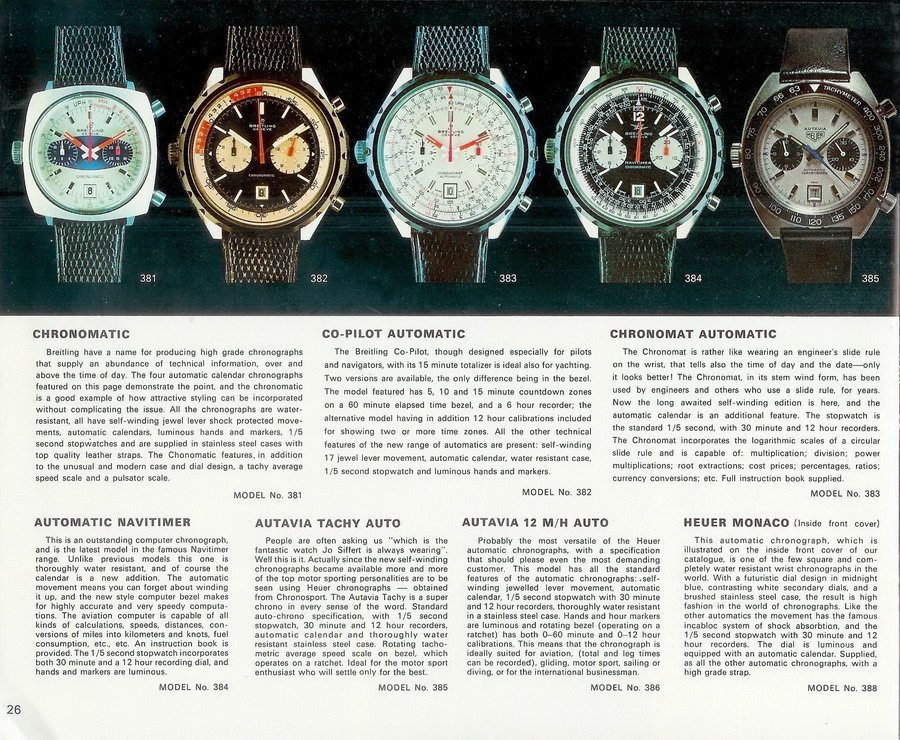
Breitling Transocean
The Breitling Transocean follows the brand’s popular Superocean. Similar to the Heritage Chronograph, the Transocean gives a nod to Breitling models past. These vintage-inspired elements include features like the typeface on the dial and the iconic Breitling “B” logo. In contrast to the Heritage Chronograph, the Transocean comes equipped with three registers. These include two chronograph and one small seconds in a tri-compax layout. When the Transocean first debuted in 1958, models housed manual chronograph movements. However, following the creation of the automatic chronograph movement, the Transocean got an upgrade. Today, we see modern touches in the collection like the Caliber B01 automatic movement and the oversized 43mm case.
Baume & Mercier Capeland Chronograph
The Baume & Mercier’s Capeland Chronograph is a much newer addition than the Heritage Chronograph and Transocean. However, the collection still draws from the brand’s chronographs of the 1940s. The Capeland line first appeared in the 1990s for a short stint. Then, the brand relaunched the collection in 2011. Throwback elements include the typeface of the hour markers and shape of the hands. Much like the Heritage Chronograph and Transocean, contemporary elements come in the form of the 44mm case and automatic movement. The Capeland houses the ETA Caliber 7750 with a 42-hour power reserve.
TAG Heuer Monaco
One of the most famous producers of the chronograph is TAG Heuer. They were among the brands who contributed to Project 99 and produced the famous Caliber 11 movement. They initially debuted it in existing models like the Carrera and the Autavia. However, the brand ultimately wanted to design a new model specifically for the movement, and the Monaco was born. The Monaco boasts a one-of-a-kind design with a unique, water resistant square case. The combination of the case shape, movement, and capabilities was a world-first when it launched in 1969. Like the Heritage Chronograph and Capeland Chronograph, the Monaco features two-registers. Now, it houses the Caliber 12 self-winding mechanical movement, which features a 40-hour power reserve.
Piaget Polo S Chronograph
Piaget’s Polo S collection is instantly recognizable for its distinctive bracelet and dial, which feature a bold horizontal pattern. They also boast a unique cushion shaped case. Though stainless steel is relatively common for most brands, the Polo S is Piaget’s first to feature the popular metal. The chronograph variation comes equipped with two registers, like the Heritage Chronograph, Capeland Chronograph, and Monaco. The Polo S wouldn’t be complete without the Caliber 1160P self-winding mechanical movement, which offers a 50-hour power reserve.
Rolex Daytona
Last but certainly not least is the Rolex Daytona. This model is one of the most highly coveted chronographs on the market. Like the Transocean, the Daytona first launched before the development of the automatic chronograph. Rolex initially began working on a line of mechanical chronographs in the 1950s. However, the Daytona marked the brand’s first official collection of chronographs. Even before the addition of the automatic chronograph movement, the Daytona introduced a number of firsts for the brand. It was Rolex’s first model to feature a tachymeter scale engraved on the bezel as opposed to printed on the dial. The Daytona was also the first to showcase a panda dial – a white dial with three contrasting black subdials.
When Rolex decided to make the switch to an automatic chronograph movement, they looked to Zenith’s iconic El Primero movement. It took over half a decade for Zenith to present their first design. Still, Rolex came back with hundreds of modifications. However, by 1988, they had finally unveiled the first automatic Daytona. Today, the collection has gotten yet another upgrade. Now, models feature Rolex’s in-house Caliber 4130 movement with a 72-hour power reserve.
Images ©: Header, 4; Crown & Caliber. 1; Louis Moinet. 2; Wound for Life. 3; ctime.com. 5; OntheDash.
Get More Articles Like This in Your Inbox
We're constantly creating great content like this. So, why not get it delivered directly to your inbox? By subscribing you agree to our Privacy Policy but you can unsubscribe at any time.





